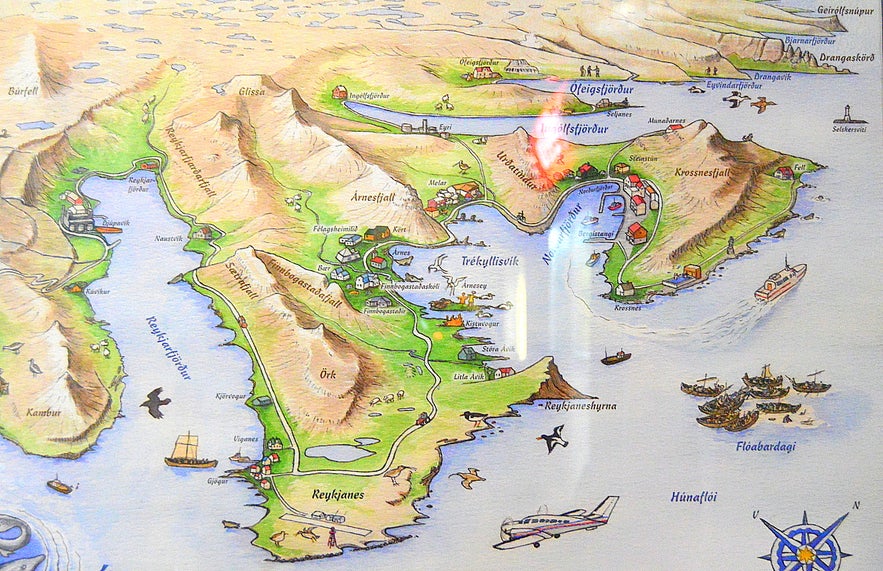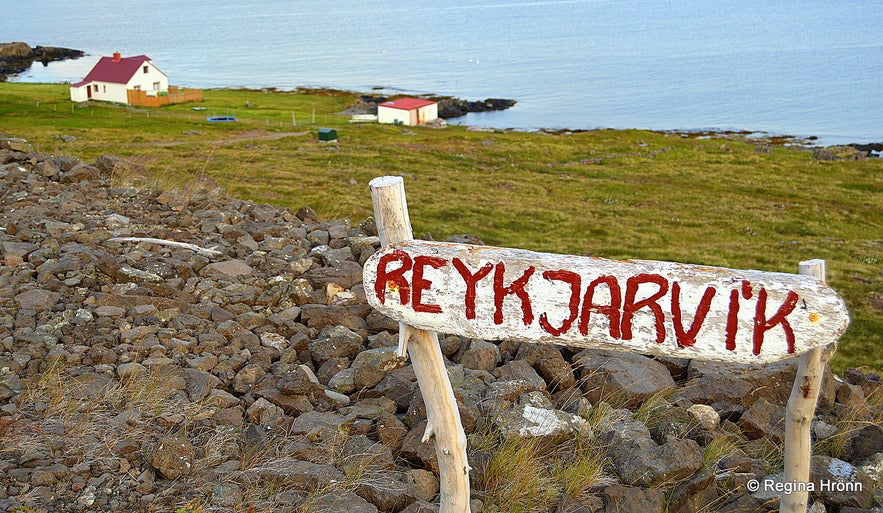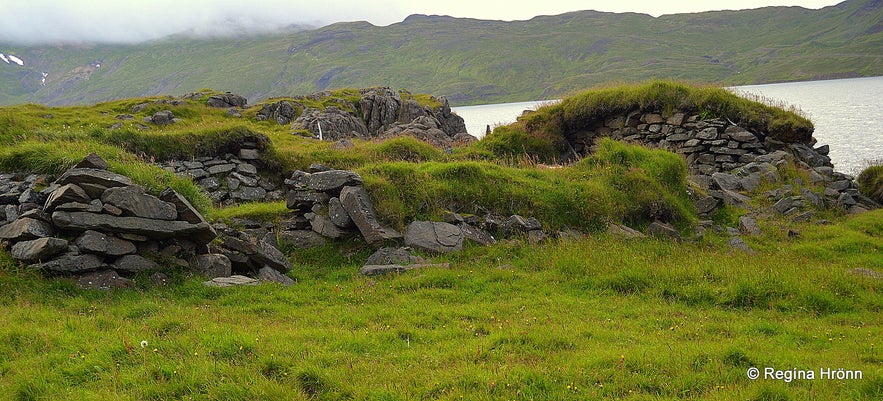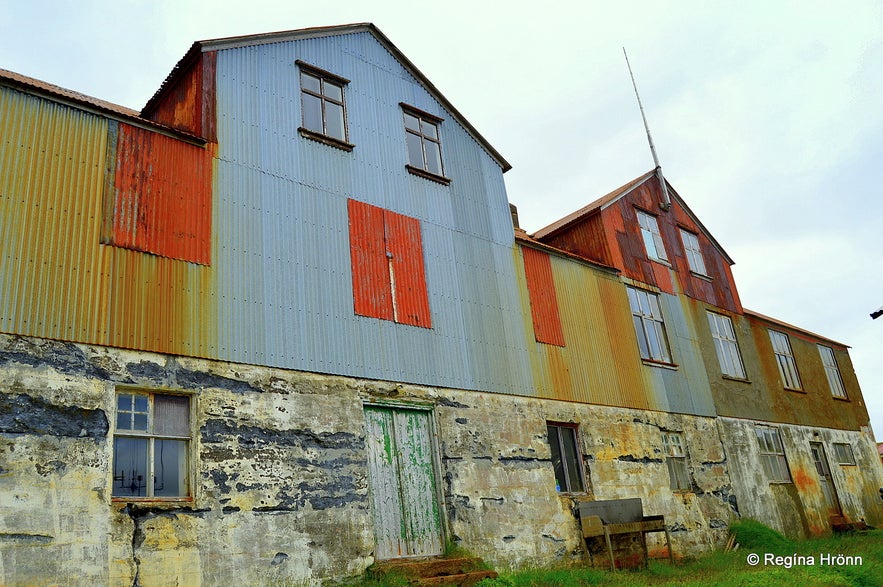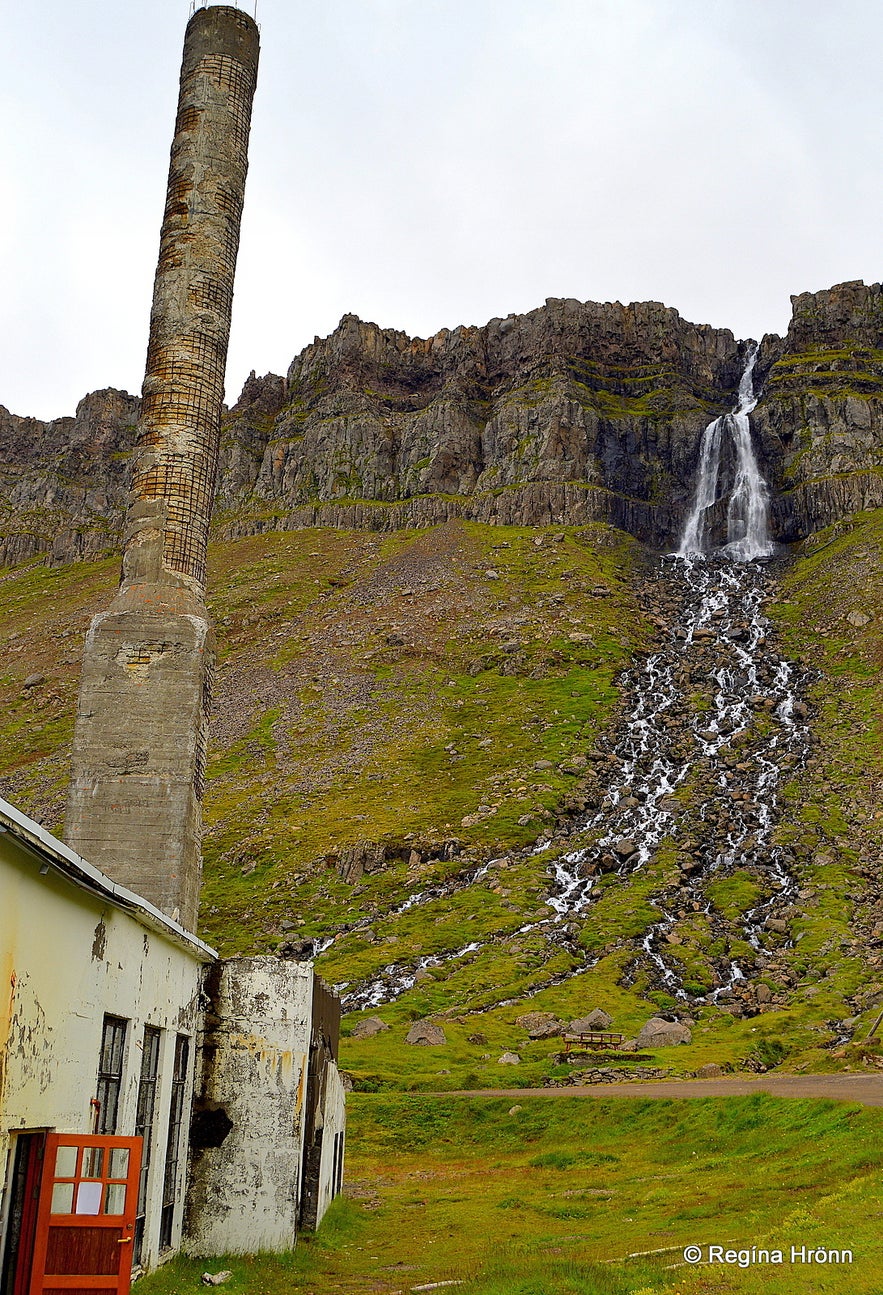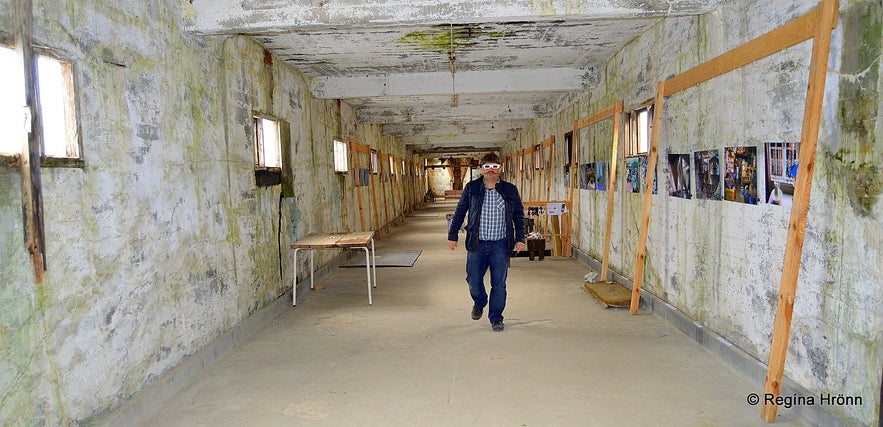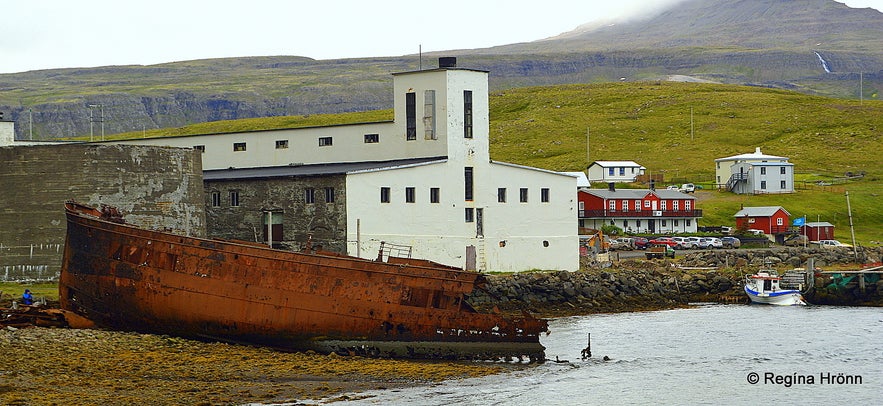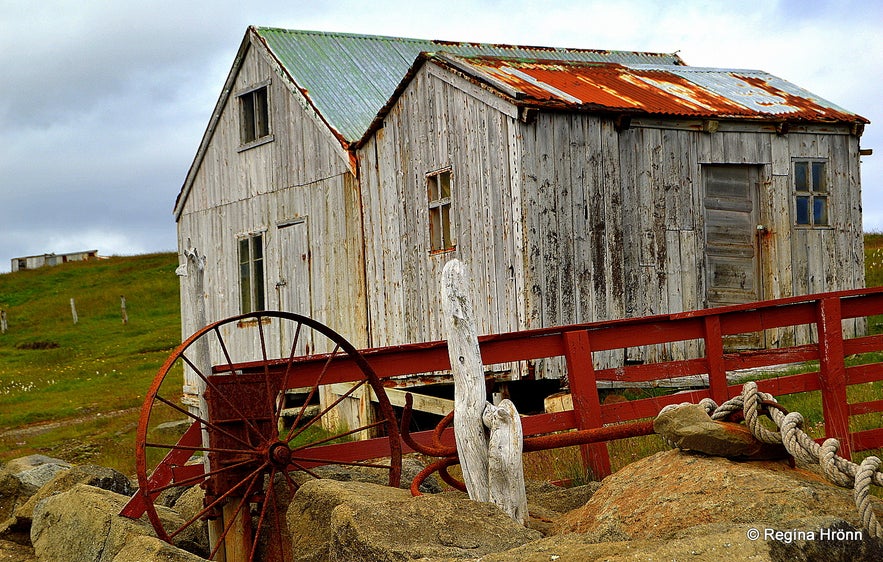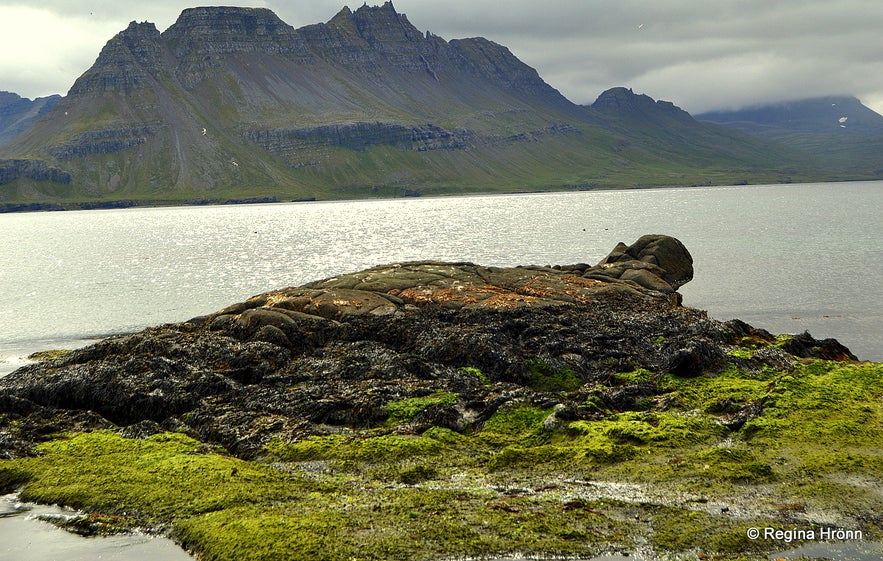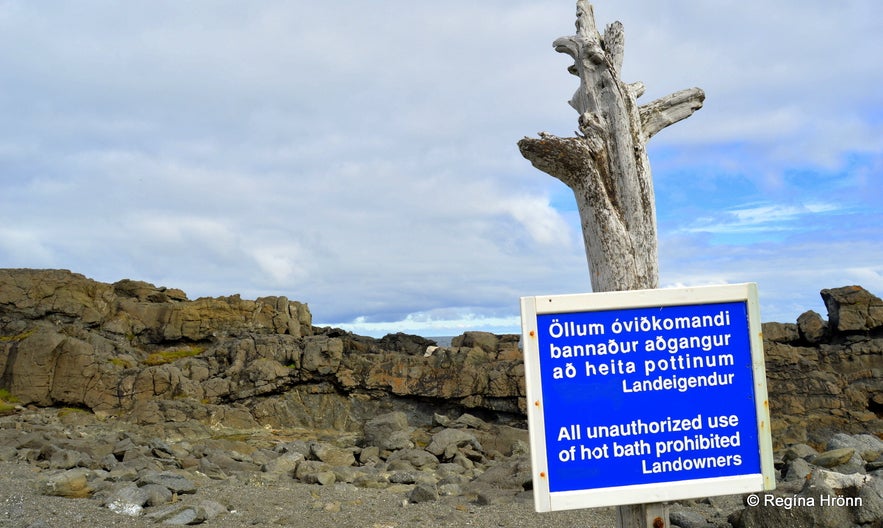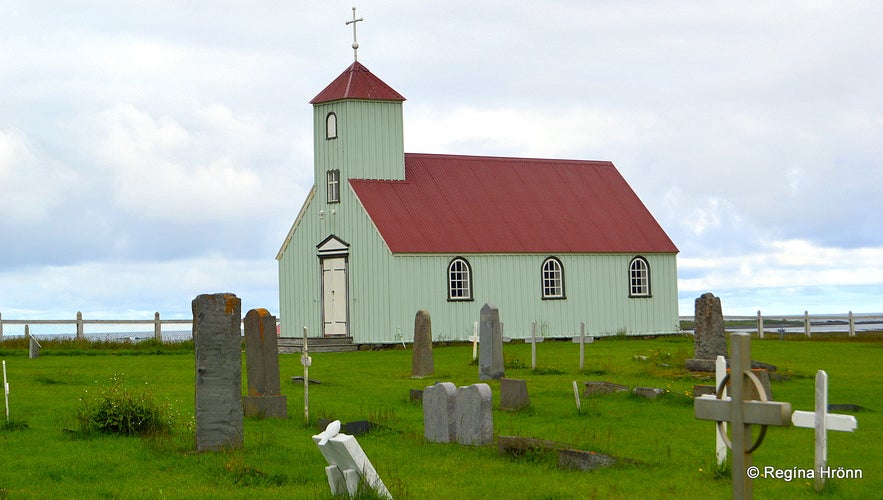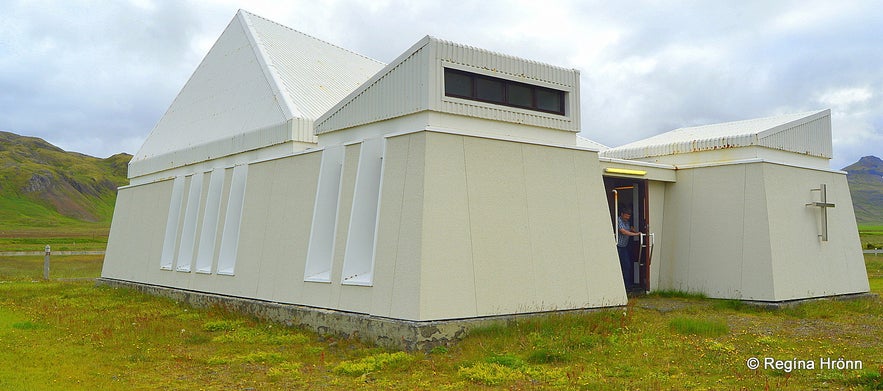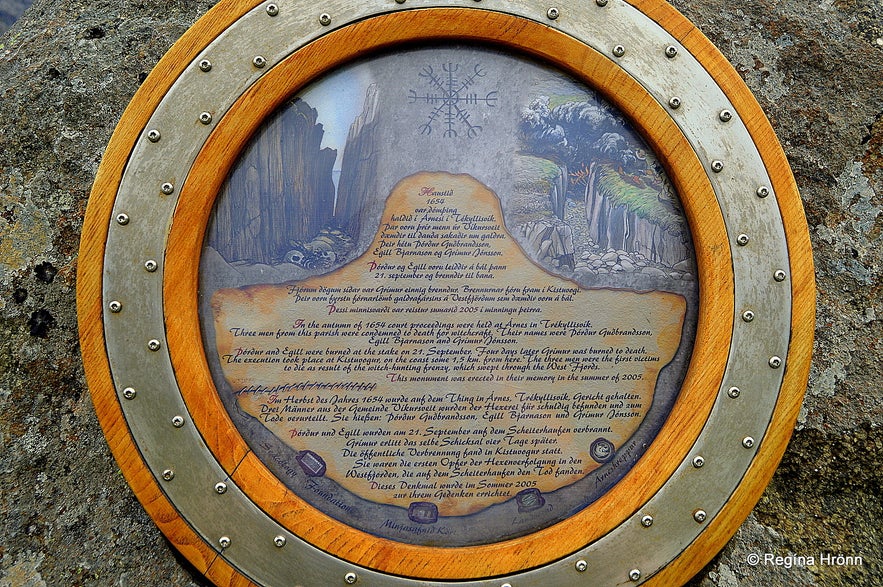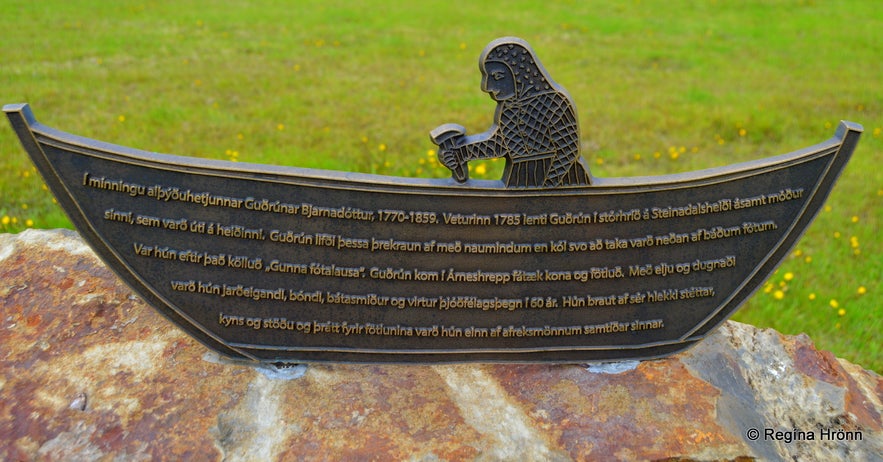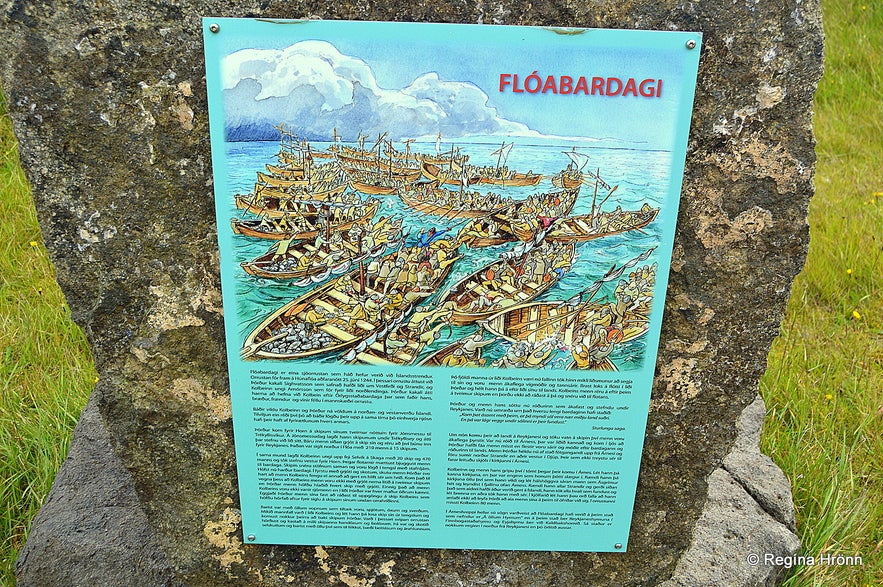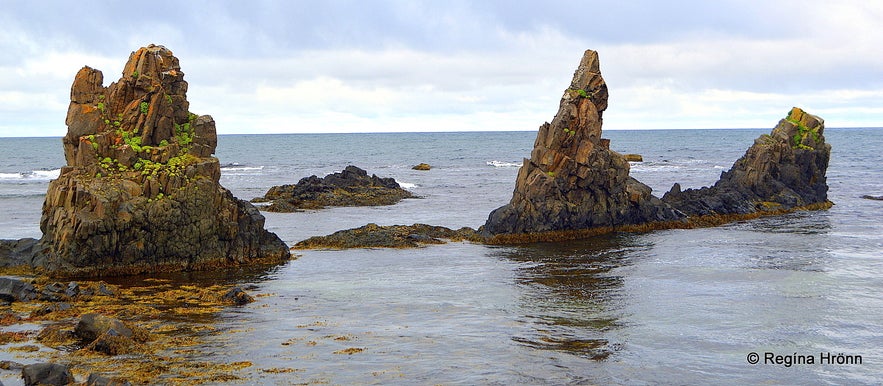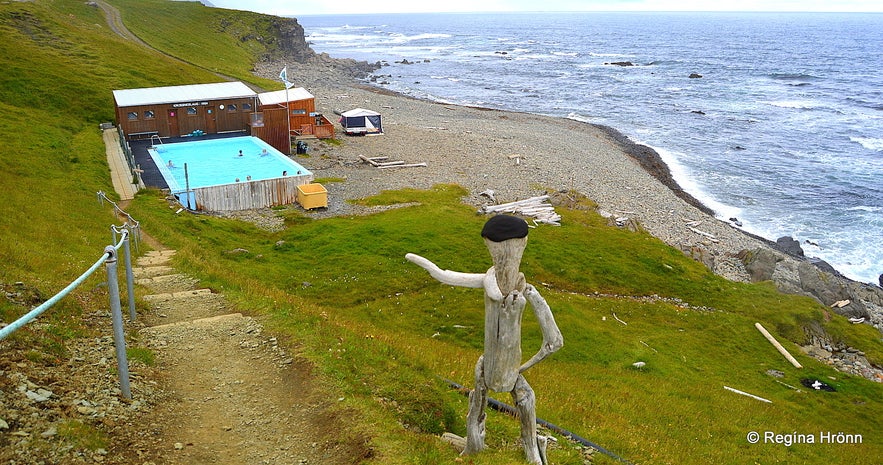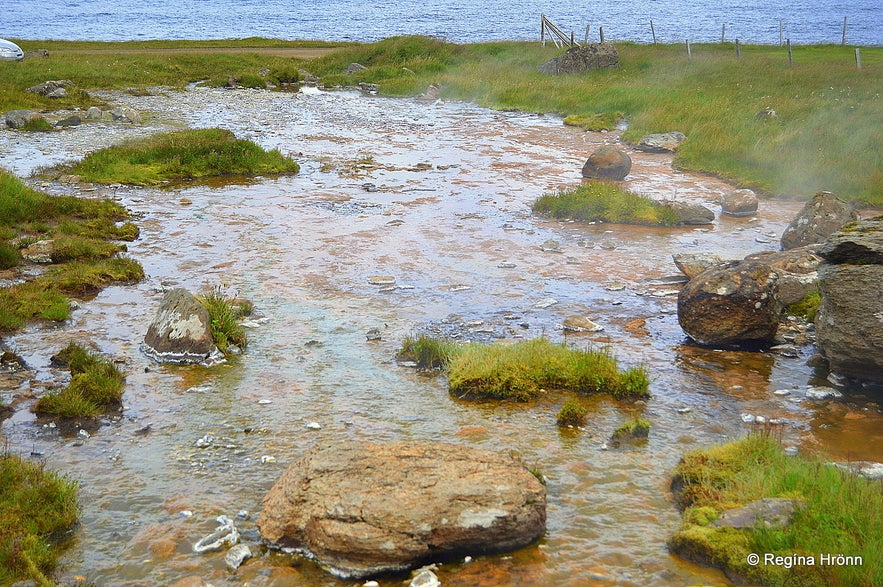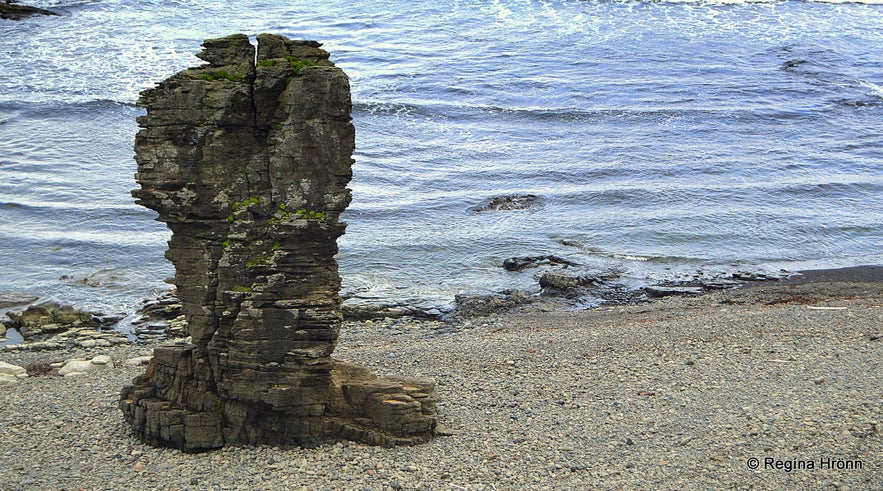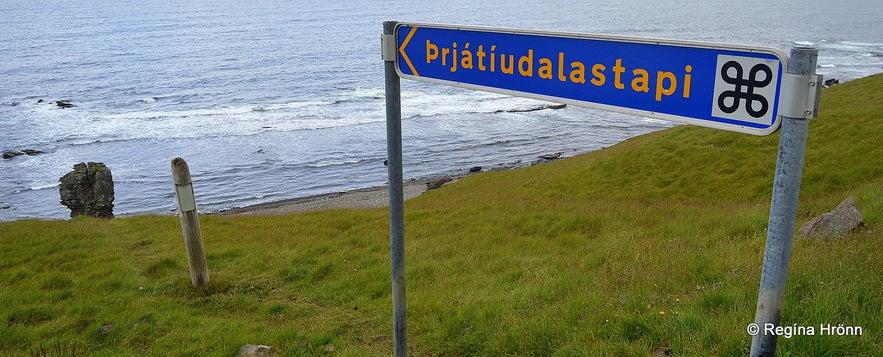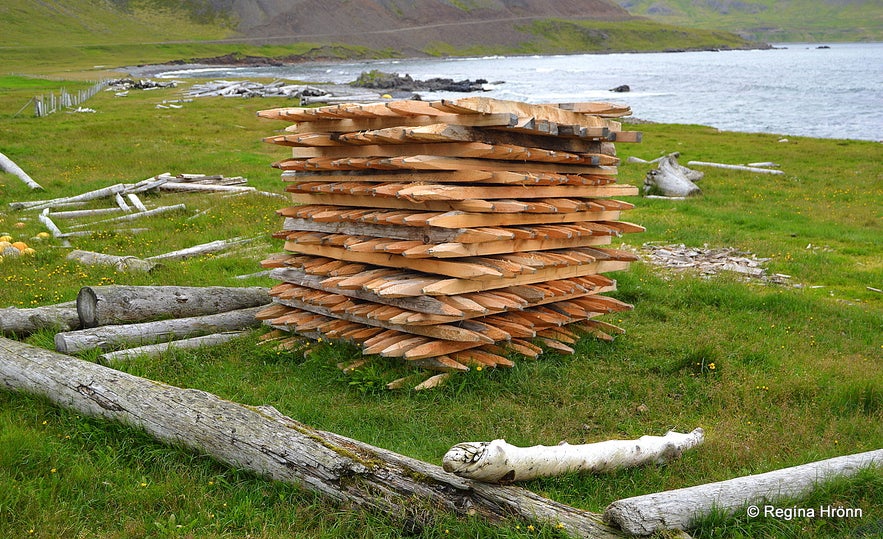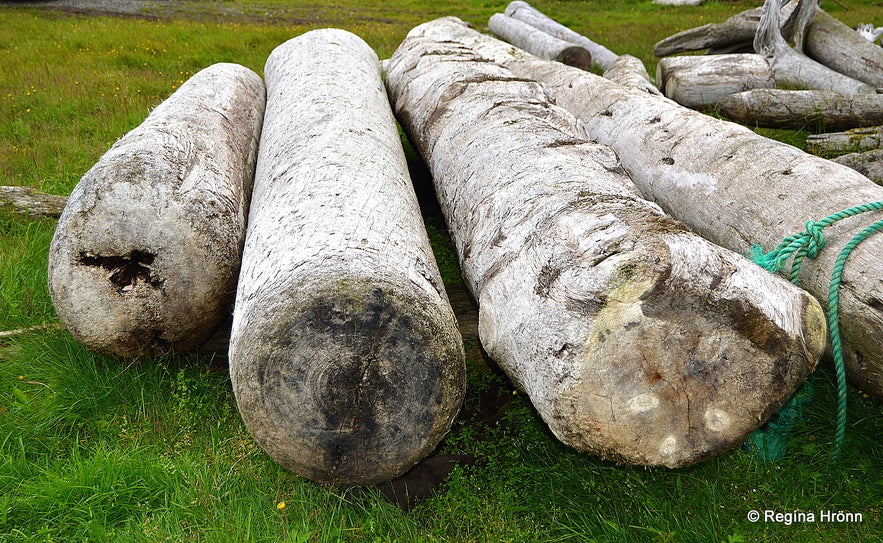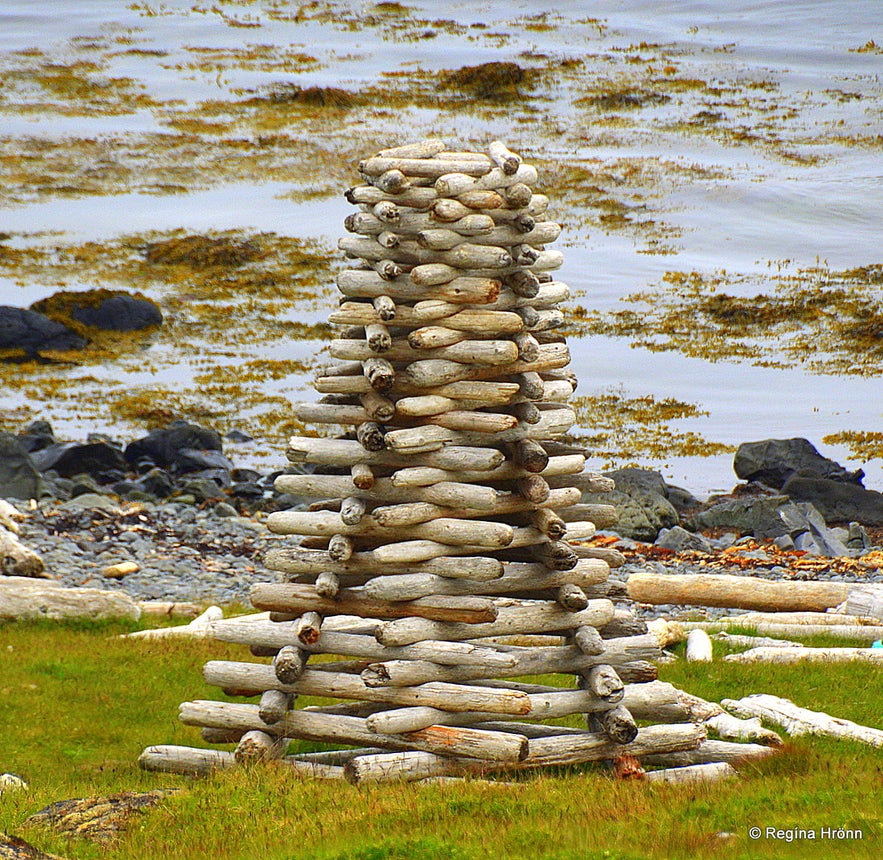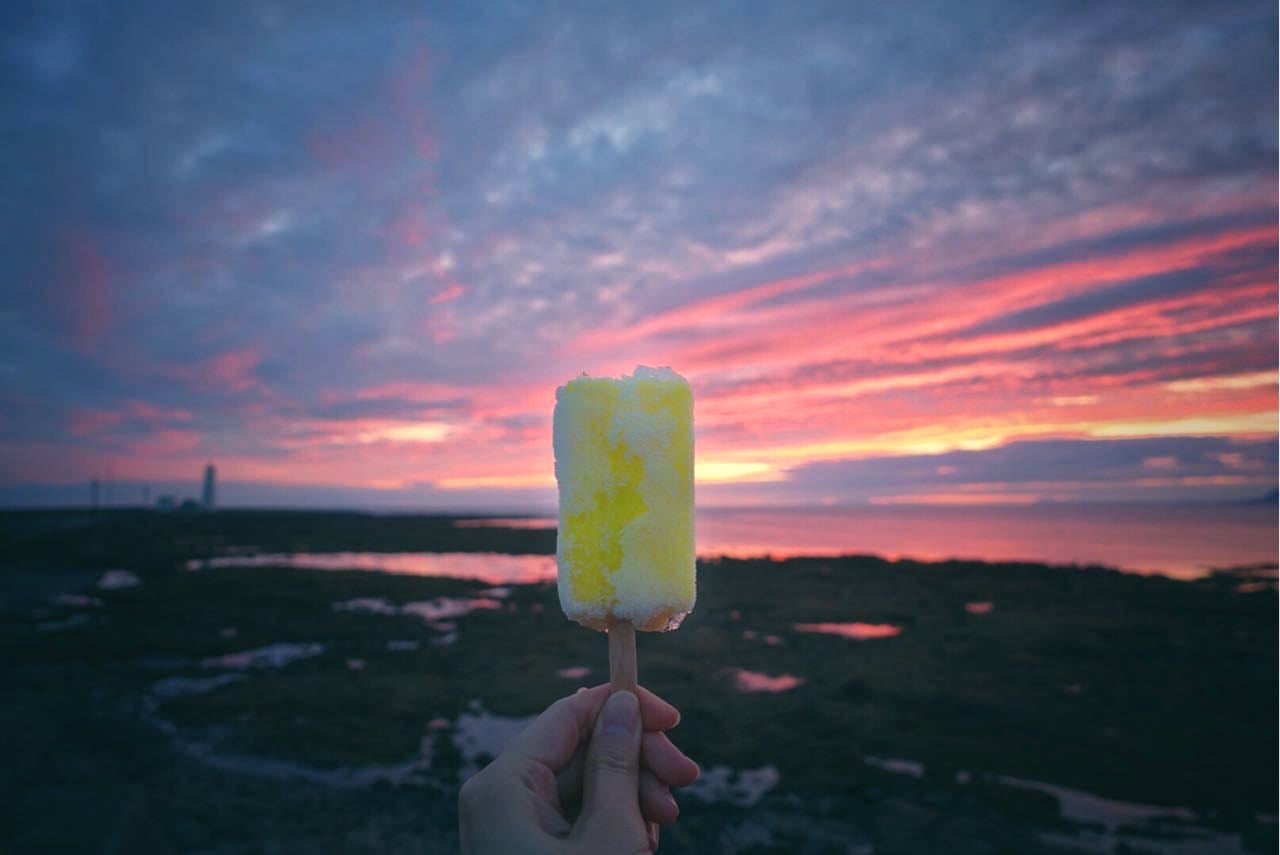Join me on a day tour of one of the remotest areas of Iceland - the scenic Strandir. While some 7,000 people live in the Westfjords Region of Iceland, 4,000 of whom live in the capital city of the Westfjords, Ísafjörður, only some 43 people live in Árneshreppur rural district at Strandir.
In my previous travel-blog, I told you about the beautiful nature and hot pools by Hotel Laugarhóll, where I stayed for the night. And showed you the lesser-known Goðafoss waterfall, which bears the same name as its famous namesake up north.
Top photo: a map of the Strandir area
Goðafoss waterfall at Strandir
Now let me show you what you can expect to see on the scenic drive to Strandir - this is not a complete guide though, just what I experienced on my day-trip to Strandir.
Strandir, by the way, is the plural form of the Icelandic term for a coast, which describes the route perfectly, as it will take you along the coastline of the eastern part of the Westfjords Region of Iceland.
Above you will see a map of this area - I saw it hanging on the wall of Hotel Djúpavík - I hope you can see it clearly enough to figure out where I will be taking you in my travel-blog. Mt. Urðartindur is not erupting - it is the reflection on the map ;)
Reykjarvík at Strandir
As you start your drive north on the scenic road number 643 along the coastline don't get startled when you see this sign above with "Reykjarvík" written on it - you are not on the wrong track ;)
Iceland's capital city is called Reykjavík - this small little cove with a single farm is called ReykjaRvík - I hope nobody will ever make the mistake of putting in the extra R in Reykjarvík into their GPS and be directed to this remote place at Strandir. Similar coincidences have taken place and people have driven for several hundred kilometres in the wrong direction after adding an extra R to the place name.
The most famous lost tourist in Iceland mistakenly added an R to Laugavegur in Reykjavík and ended up in LaugaRvegur street in Siglufjörður 380 kilometres away from his hotel.
Kúvíkur
Kúvíkur at Strandir
First, we visited the ruins of the only trading place in Strandir for 250 years or until Borðeyri in Hrútafjörður took over as a trading place in 1846. At Kúvíkur, shark liver oil was the main commodity.
People lived here at Kúvíkur until the mid 20th century when the latter herring adventure started in Djúpavík and trading moved there (see my next stop).
The road to Kúvíkur is a bad gravel road and we left the car when we saw a 4x4 sign and walked the rest of the way down to the seashore. Here you will see so many ruins of houses and stores - turf houses and even concrete cellars.
Some of the inhabitants dismantled their houses and took them with them to the new location at Djúpavík.
Ruins at Kúvíkur at Strandir
The descendants of the inhabitants of Kúvíkur have marked their houses with copper shields and seeing the names of the people living and working here makes the connection to the inhabitants of this old trading station even stronger.
It is quite interesting having a look at Kúvíkur and one can imagine and almost hear the vibrant life and trading of the preceding centuries in this now desolate place.
Djúpavík
Djúpavík at Strandir
Djúpavík is a very small hamlet in the fjord Reykjarfjörður. Here a herring factory was first established back in 1917. That factory operated until 1919 during the era of the first Herring boom. The factory was closed in 1919 when the owner went bankrupt during a recession.
The latter Herring boom started in 1934 and a big state-of-the-art herring factory - the biggest herring factory and the biggest concrete building in Iceland at that time - was opened in 1935 and operated for around 20 years.
I have heard that around 500 people were living and working here at some point making this remote area of Iceland come very much alive for a time being!
Unfortunately, this area saw a decline in herring after 1944, which caused the factory to close its doors some 10 years later after some rough years following the disappearance of the herring.
Djúpavíkurfoss waterfall at Djúpavík at Strandir
People left Djúpavík turning this former vibrant community into a ghost village, as it were, until 1985. Here the old concrete factory from the latter boom stood deserted for 30 years.
Now you will find a hotel at Djúpavík named after the cove, Hotel Djúpavík, which operates all year round. The hotel is located in the former quarters of the female workers in the herring salting factory.
During your visit to Strandir, you can pop in there for a meal at the restaurant or have a cup of coffee and say "hi" if you are feeling alone in this remote part of Iceland.
In one part of the old factory, you can visit a photographic exhibition. I can tell you that there is something so eerie about visiting this exhibition and looking through the bars into the old deserted factory.
Djúpavík at Strandir
Three large silos are located next to the abandoned factory. My husband insisted on climbing the stairs leading to the top of one of the silos, but I settled for looking through one of the outlets of it. Do be careful though while visiting the factory and the silos!
in 2025, Baskasetur Íslands - the Icelandic Basque Centre, was opened in one of the herring silos. At Baskasetur you can learn about the Basque whalers, who haunted whales by Iceland.
You will also learn about the sad fate of the Basque whalers in 1615, called Spánverjavígin - the Slaying of the Spaniards, which is a stain on Iceland's history.
Djúpavík at Strandir
In 2016 scenes from the American superhero film Justice League with Ben Affleck and Jason Momoa (remember Khal Drogo in Game of Thrones) were filmed here at Djúpavík, making this remote place come alive again for a while. During the week of the filming, there were some 350 people at Djúpavík!
In this scarcely populated area, you could see three helicopters and five private jets plus around 200 camper vans, carrying and accommodating the actors and the crew.
And back in 1977 the Icelandic horror film Blóðrautt sólarlag - Crimson sunset was filmed here in the factory. I remembered scenes from that film too well during my visit to the factory, which made my blood curl ;)
In the summer of 2006, the popular Icelandic band Sigur Rós held a free concert in the Djúpavík herring factory. It was a part of a series of free concerts all around Iceland after several years of the band touring the world. Sigur Rós made a film about their free, unannounced concerts in Iceland called Heima.
Behind the factory by the shore, you will find an old shipwreck rusting away - it is the cargo and passenger ship Suðurland. It was used as sleeping quarters for the workers.
Djúpavík at Strandir
The other houses in this very small village are only used in the summertime. We are now in Árneshreppur ca 360 km from Reykjavík with the population in this rural district being around 50 people only.
A beautiful waterfall, Djúpavíkurfoss - also called Eiðrofi or Breach of Oath, cascades down into Reykjarfjörður next to the factory, creating a beautiful scenery.
Gjögur
Gjögur at Strandir
Gjögur is another small settlement in Reykjarfjörður fjord and even though this is such a tiny little village, here you can find an airstrip, which serves as the only transport during the winter months!
This settlement was once a big (I must reiterate Iceland style) fishing station for shark fisheries with up to 15 boats hunting for sharks at the same time.
So once upon a time, this area was vibrant with the smell of shark liver oil filling the air. Back then shark liver oil was a valuable commodity for export.
Gjögur at Strandir
At Gjögur I got permission from the landowners to bathe in a secret hot pool close by.
This pool is closed to travellers as it is privately owned and trust was broken when litter and bottles were left behind by visitors to the pool :( Too bad!
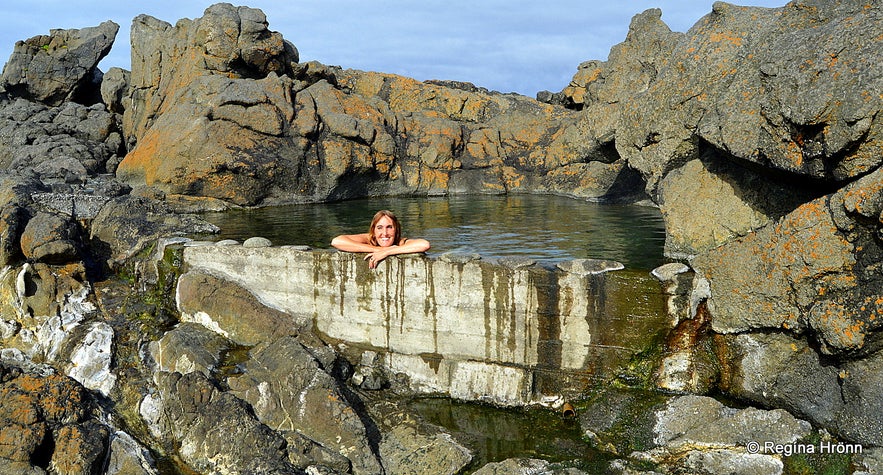
Somewhere at Strandir ;)
Even the actor Jason Momoa entered the pool without asking for permission while filming at Strandir, making the owners of the pool livid. Jason probably did not realize that he needed permission from the landowners to enter this private geothermal pool.
There are some wonderful hot pools in the Westfjords of Iceland about which I have written a travel-blog Hot Pools in the Westfjords of Iceland - a Selection of the Natural Pools I have visited but this hot pool will remain a secret just because some people have to ruin it for the rest of us :(
So I will keep it hidden and refer to Krossneslaug pool a little bit further on, which is a wonderfully unique swimming pool right by the sea further up in Strandir.
Trékyllisvík
Árneskirkja gamla church at Strandir
Now let's have a look at the oldest structure in Strandir - the old Árneskirkja church in Trékyllisvík. The current church dates back to 1850, but the first mention of a priest here is from 1237.
You will notice a more modern church opposite the road from the old church. That church, also called Árneskirkja, dates back to 1991. The altar is distinctive as it rests on two basalt columns from this area.
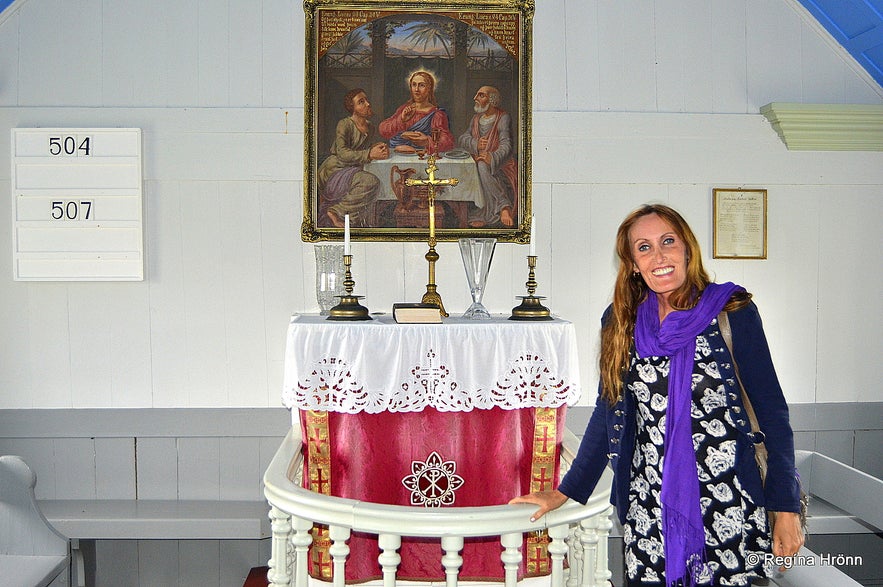
Inside Árneskirkja the older one
The first instances of what was believed to be sorcery took place in Árneskirkja church back in 1654.
Nowhere else in Iceland has sorcery hit Iceland as hard as at Trékyllisvík.
Here the first so-called sorcerers, Þórður Guðbrandsson, Egill Bjarnason and Grímur Jónsson, were burnt at the stake in the year 1654 at Kistuvogur cove after court proceedings at Árnes in Trékyllisvík.
Árneskirkja nýja church at Strandir
These 3 men were found guilty of witchcraft and were the first victims of a witch-craze, which swept through this area.
This dark period of time in Iceland, from 1654-1690, is referred to as Brennuöldin or the Fire century.
The so-called sorcery didn't stop even though these three men had been burned at the stake and in 1670 two men were flogged here at Trékyllisvík for sorcery. Another 16 men and only 1 woman were burnt at the stake here in Iceland, the last one in the year 1683.
A memorial for the sorcery period at Strandir
Strandir is well-known for being the sorcery part of Iceland, which makes it even more mystical driving through this remote part of my country. Don't forget to visit the Museum of Icelandic Witchcraft and Sorcery in Hólmavík before visiting this area.
Not to forget the mystical Sorcerer's Cottage at Klúka in Bjarnarfjörður - do pay it a visit - it is located next to Hotel Laugarhóll, where I stayed for the night on my visit to Strandir.
In 1665 there are accounts of 7 polar bears coming ashore at Trékyllisvík - what a frightful period of time the 17th century was for these poor people.
The memorial for "Gunna fótalausa" at Strandir
Close to the two churches, you will find the museum and gallery Kört where the locals sell artwork made from f.ex. driftwood. The museum/gallery is open from 10-18 in the summertime.
By the museum, you will find information signs mounted on rocks on Flóabardagi battle, on Sorcery in Trékyllisvík, and on the most "famous" outlaws in Iceland Fjalla-Eyvindur and Halla, who lived here for a while at Drangavík during their outlawry. I also noticed this memorial above of Gunna fótalausa - the legless Gunna.
From Trékyllisvík preparations were made for Iceland's only sea battle (excluding the Cod Wars and WW2) on the 25th of June 1244 - Flóabardagi battle - the Battle of the Gulf. Sturlunga Saga describes how Þórður kakali Sighvatsson gathered men from the Westfjords and Strandir.
The memorial for Flóabardagi at Strandir
He prepared his ships by Trékyllisey island in Trékyllisvík - 15 ships and 210 men.
He met the fleet of his enemy Kolbeinn ungi Arnórsson at Húnaflói bay - 20 ships and 470 men from the Northern part of Iceland. Kolbeinn had prepared his fleet at Skagi.
This battle was to have dire consequences for the Strandir area. Kolbeinn lost 80 of his men and followed Þórður kakali up to Strandir and ransacked this area.
You can read about this only sea battle in Iceland where both parties were Icelanders in Sturlunga Saga.
Árnesstapar rocks - to the left is the female troll, then the male troll, and to the right is their dog
You will notice 3 pillars of rock in the sea just outside of Árnes - called Árnesstapar. They are, according to legend, believed to have been 2 trolls and their dog, who had been turned into stone on their way back from a troll gathering at Drangajökull glacier - Iceland's northernmost glacier.
You will notice, as you drive along the coastline of Strandir, the many pillars of rock along the way - many of which are related to folklore.
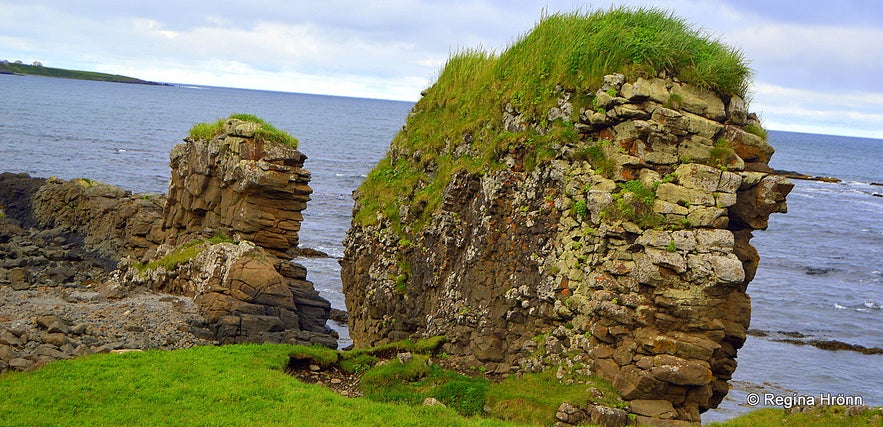
Two of the many rocks I saw on the coastline at Strandir
It is a well-known fact here in my country that pillars of rock are trolls that have been turned into stone by the first rays of the sun.
Here you can really hear the sounds of silence as this is about as remote as you can get in Iceland in a car.
Norðurfjörður
Norðurfjörður at Strandir
Next, we encounter Norðurfjörður. In Norðurfjörður trading began in 1889 and lasted for more than a century or until 1985. By 1900 export was mainly shark liver oil and salted cod.
Here you will find another small settlement and even a small supermarket, Kaupfélag Steingrímsfjarðar, a gas pump, banking, a café, and sleeping accommodation.
Just before you reach this small settlement you will notice the pillar of rock on the beach, one of many in this area, called Stórukleifarstapi
Norðurfjörður at Strandir
The story goes that Bishop Guðmundur góði- the Good - remember him from my travel-blog of Gvendarlaug by Hotel Laugarhóll - had sat in a hole in this pillar of rock while he blessed the screes Urðir in Urðartindur and drove monsters away.
From there on the hole was called Biskupssæti - the seat of the bishop.
Many an accident had taken place by the screes before he blessed them. I don't have a photo of Stórukleifarstapi, but I add a photo I took while visiting Norðurfjörður.
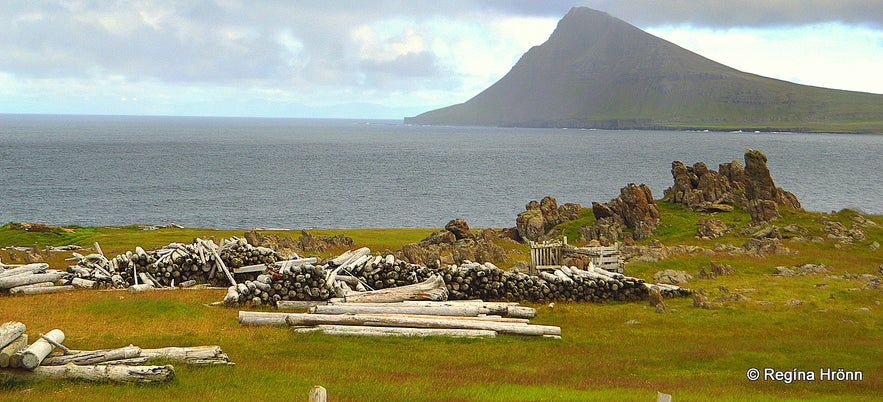
This is the only photo I have got of Mt. Reykjaneshyrna
From here you will see Mt. Reykjaneshyrna (316 m), which is a prominent mountain at Strandir.
Krossneslaug
Krossneslaug swimming pool
North of Norðurfjörður you will find the extraordinary Krossneslaug swimming pool, which is as far as the road will take you. Krossneslaug is quite a unique swimming pool, which has by some been called the best-kept secret in the Westfjords Region.
It is located on the beach at Laugarvík cove right next to the storm-tossed North-Atlantic ocean.
This swimming pool was built by the Youth Association Leifur heppni (Leif the Lucky) and taken into use in 1954. Here children in the rural district of Árnes got swimming lessons.
It is just magical soaking and swimming in a hot swimming pool right next to the cold North-Atlantic ocean with Mt. Krossnesfjall towering above on the other side of the gravel road.
Krossneslaug swimming pool
You park your car in the parking above the swimming pool and pay a small admittance fee, and head for the changing rooms, which happened to be filled with people when I got there - apparently the word got out. Don't forget to shower before entering the pool :)
On the other side of the road, you will see a geothermal area with a couple of hot springs and mud pools called Krossneshverar. From this geothermal area, the hot water in Krossneslaug swimming pool originates. Geothermal water is also led by a pipe to the farm of Krossnes.
Icelandic folklore apparently tells us about the sorcerer and poet Jón lærði Guðmundsson signing a contract with the devil in the 17th century to channel the water from the geothermal springs into the farm - without success.
I haven't been able to find the source of this folklore - it is not written in Þjóðsögur Jóns Árnasonar - the Collection of Folklore of Jón Árnason, which I often refer to, but it must be true all the same.
Krossneshverar geothermal area
The drive to Krossneslaug is only some 81 km from Hotel Laugarhóll but seems much longer as we are driving on a gravel road here in Strandir, which winds around the mountains and goes mainly by the rugged sea.
This is practically as far as the road goes, but if you go a tiny bit further you will see a lone pillar of rock standing on the beach.
Þrjátíudalastapi
Þrjátíudalastapi rock
A distinctive pillar of rock, 10 m tall, stands on the beach just north of the swimming pool - it is called Þrjátíudalastapi. The name Þrjátíudalastapi - Thirty Dollar Pillar of Rock refers to an old account - a skillful climber mounted the pillar of rock and left 30 dollars on top with the instructions that the person who could climb the pillar would get the money.
A seaman from Eyjafjörður in North-Iceland succeeded in climbing the pillar of rock, but didn't find the money - he left a piece of wood instead in a slot on top of the pillar.
Then in 1986 three men from Krossanes succeeded in climbing the pillar. They neither found the money nor the piece of wood - so they put another piece of wood in its place.
Do not climb this pillar of rock though, it was mounted by experienced climbers.
Þrjátíudalastapi rock
Now we have to drive back the same way as the road ends by the farm Fell close by. We decided on making a day trip to this part of the Strandir area and stay at Hotel Laugarhóll, but you can also stay here for longer at f.ex. Hotel Djúpavík.
Ingólfsfjörður
Ingólfsfjörður fjord
On the way back we took a detour to Ingólfsfjörður fjord just to see what it looked like. We didn't drive into the fjord but had a peek at it from above. From there you have a good view of Drangaskörð on a good day. We saw the abandoned herring factories and the herring plant built at Eyri in 1942.
There was something eerie about looking into this abandoned fjord where once you would have seen a vibrant community. Even eerier was to look in the direction of Drangaskörð at Hornstrandir, where cars cannot drive and only boats and hikers can reach.
I watched the mystical Drangaskörð enveloped by the fog - one day I will succeed in visiting this part of Iceland. My photo of Drangaskörð is not good enough to be posted, but you can see what it looks like here.
Driftwood at Strandir
Along the way, you will see driftwood in abundance. And even artwork made from the driftwood, which has drifted a long way to Iceland from Siberia.
Driftwood and seals were the main resources here at Strandir. Driftwood was a godsend in Iceland which is void of trees.
Some of the driftwood is huge! The inhabitants used driftwood for building houses, for heating, for making all kinds of art and craft, etc. - it truly was a godsend.
It pains me to mention that driftwood was also used in Strandir for burning innocent people at the stake in the 17th century.
An Arctic fox in the driftwood
If you look closely you will see a dead Arctic fox beneath the driftwood in my photo above. In this area of Iceland, Arctic foxes can be seen frequently, but I only saw this dead one though on my travels through Strandir.
You might notice some artwork made from the driftwood and other flotsam at Strandir. Some of it was made by the German environmentalist and concept artist Michael Thomas, who has built installations around the world.
He made the Earth Valve, Ironbird's Nest, and Spaceship Mitschdóttir. He spent some 10 days in the Strandir area on this project, trying to raise people's much-needed environmental awareness.
Artwork of driftwood at Strandir
Just in case you were wondering why some of the flotsam has been so beautifully stacked ;) I saw this one above at Kaldrananes by Drangsnes.
The area of Strandir is hauntingly beautiful and draws you back for a visit. Beware of the Strandir fog though, which is believed to be conjured up by sorcerers. Here many of our trolls-, elf- and ghost-stories have originated.
To visit the Westfjords Region of Iceland you can rent a car in Reykjavík and drive up there on your own.
On the map, you will see the distance from Hotel Laugarhóll, where I was staying for the night, to Krossneslaug swimming pool, which was as far as I drove in Strandir on that day. The distance is around 81 km one way.
Also, check out these travel-blogs I have written about the Strandir area:
Drangsnes at Strandir in the Westfjords Region of Iceland, the Troll and the Hot Tubs
The Museum of Icelandic Witchcraft and Sorcery at Hólmavík in the Westfjords Region of Iceland
Hólmavík in the Westfjords Region of Iceland - the Sorcery Town!
Whale Watching from Hólmavík in the Westfjords Region of Iceland with Láki Tours
Have a lovely time exploring the remote and serene Strandir :)

